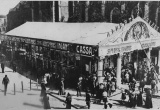Dutch Film Production until 1900
In June 1896, Amsterdam-based photographer M.H. Laddé made three short films that were shown in Christiaan Slieker's travelling cinema from Leeuwarden. One year later, A.C. van Dijck filmed the fire brigade practising at the Delftse Gist- en Spiritusfabriek (‘Delft Yeast and Alcohol Factory’). After that, Dutch film production stagnated; for cinematic images of the Netherlands, people had to rely on films from other countries.
It was Lumière representative Camille Cerf who organised the first film show in the Netherlands on 12 March 1896. Although Cerf regularly made films in most countries he visited, he failed to shoot any footage while in the Netherlands. This was left to the next foreign exhibitor: the English film pioneer Robert William Paul.
Paul (or one of his representatives) came to the Netherlands to show films with his Theatrographe and made two recordings along the way: Aan boord van de mailboot ‘Koningin Wilhelmina and De zee te Scheveningen. These films were shown in both an empty shop in the Vijzelstraat in Amsterdam and at the Kurhaus, a prominent hotel in Scheveningen. The latter screening was organised by a Lumière representative.
Coronation of Wilhelmina international news
Things were relatively uneventful until September 1898, the month when Princess Wilhelmina was crowned queen of the Netherlands. The British Mutoscope and Biograph Syndicate sent their cameraman William Dickson to the Netherlands to film this event and F.A. Nöggerath, sen. had director Charles Urban from The Warwick Trading Company and one of his cameraman come over from London to shoot the festivities. The films were immensely popular in the Netherlands, and were shown abroad as well.
After the Dutch branch of Mutoscope – called Nederlandsche Biograaf- en Mutoscope Maatschappij – was founded in 1898, Dutch film production began to increase. This was again primarily thanks to a foreigner, Mutoscope cameraman Emile Lauste, who came to the Netherlands to record the First Peace Conference of 1899 in The Hague and to make cinematographic inserts for August Reijding’s revue 'De nieuwe prikkel'. It is possible that Lauste also shot three additional inserts in Scheveningen, but these were never included in the revue.
New development: local films
Around 1899, a shift started to become noticeable: more and more Dutch film exhibitors began to use their own films in their film shows. F.A. Nöggerath, sen. and Stefan Hofbauer, a film operator in Rotterdam from the Nederlandsche Biograaf en Mutoscope Maatschappij, were particularly active in making local films. The travelling cinema showmen were also active: exhibitors such as Fey, Grünkorn, and Antoon and Andries Wegkamp all also shot local films to supplement their programmes, which were primarily made up of foreign films.
This was the start of a tradition that would continue until 1910, and whereby local recordings were an integral part of the film programme.
more information
If you are looking for more material from our collection, please contact Film Sales:
sales@eyefilm.nl
phone +31 (0)20 5891 426

